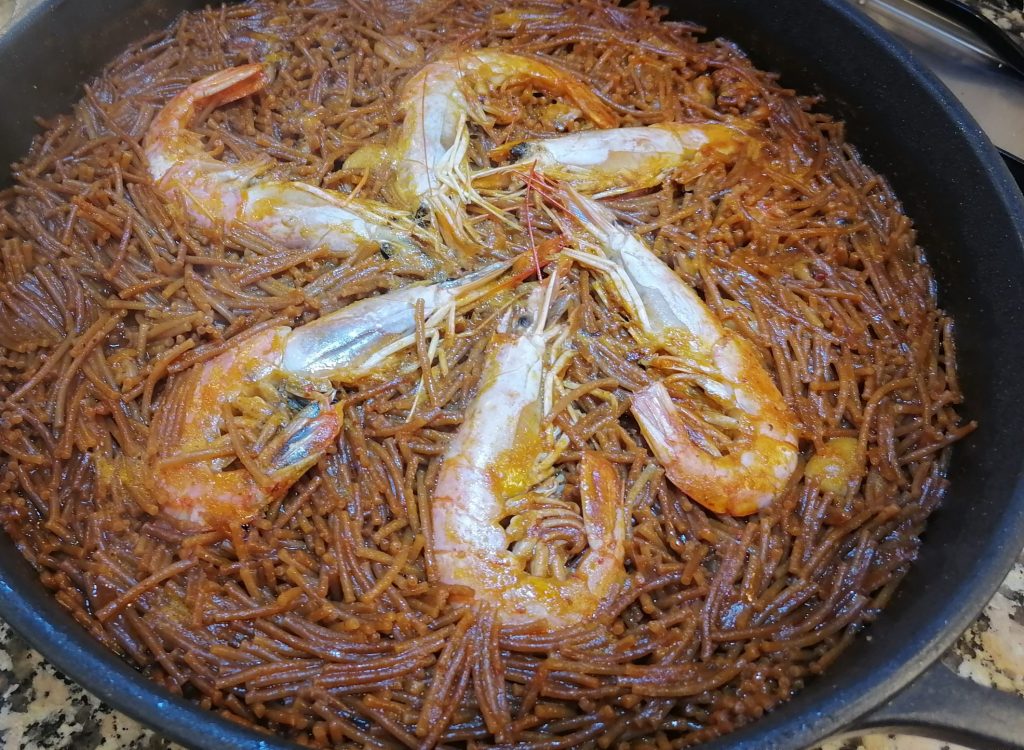Fideus rossejats are a very important sailor dish and common in Tarragona[1]. These are noodles that are toasted in a casserole with good extra virgin olive oil until they take on a characteristic golden color, to later be cooked in a tasty fish stock. In the most traditional recipes of the fishermen, this dish does not have any other ingredient other than noodles, oil and a good broth, although sometimes the diner will accompany it with a little aioli. This dish should not be confused with the fideuà from Valencia, although this term is sometimes used.
In this recipe we propose to cook the rossejats noodles with a certain amount of Romesco base mix, which gives the dish a delicious and very Tarragona aromatic tone. It should be noted that with this recipe, the author and Enrique Alonso —his regular cooking partner— obtained the first prize in the V Concurs de fideus rossejats, held on July 1, 2012 in the Serrallo of Tarragona.
Ingredients for 6 people:
• 2 fried dried ancho peppers (see the section How to fry the dried ancho peppers for the Romesco recipes).
• 6 garlic cloves, peeled.
• 1 small peri-peri chilli (expendable).
• 1 sprig parsley, finely chopped (if you have it).
• 10 almonds and 10 hazelnuts. Better if they are roasted, not raw, fried or salty. They must be peeled one by one from the fine dark skin that covers them (blanched).
• 100 g of fresh striped tomato.
• 1 package of 500 g of noodles of thickness of the number «2».
• 500 g sliced clean squids.
• 100 ml of white wine.
• 125 ml of extra virgin olive oil.
• 6 prawns.
• 1.3 l of intense fish stock.
Preparation.
Preparation of the romesco base mix:
• Prepare the small chilli by cutting the upper part and emptying it of seeds.
• Add the parsley, the peeled garlic cloves, the cayenne chilli, the tomato, the almonds and hazelnuts and the glass of wine into the mixer and mix well. The wine serves mainly to dilute the mince so that the blender can work, so the right amount of wine is added to achieve it. Since this recipe uses striped tomatoes, it could be that the necessary amount of wine to add is minimal.
• We also add the fried dried ancho peppers one by one and the chilli, and reduce everything to a fine paste with the mixer.
Preparation of the dish:
• In a frying pan, fry the Romesco base mix in just a little olive oil for about two or three minutes, stirring constantly so that it does not stick. Then we add the squid and sauté for another five minutes so that the squid lose their water. We reserved this mix well reduced.
• In this recipe we are going to use a 32 cm non-stick casserole. in diameter, although others can be used. We add 125 ml to the casserole. of extra virgin olive oil.
• When it is hot, pour in all the noodles and stir them non-stop with two wooden ladles and over medium heat, so that the noodles are toasted but do not burn or turn black. This work requires patience and full attention, as you cannot stop stirring at any time or the noodles will burn.
• When we achieve a nice, homogeneous and high toasted tone in all the noodles – about five minutes—, we add the broth that we will have already prepared and hot very little by little. Be careful, as the casserole is now very hot and broth steam can rise onto your hands.
• Add the Romesco and squid base fry that we had reserved, mix it well with the broth and the noodles and adjust the salt and pepper.
• When it boils again, we count ten minutes. Then we put the prawns in a circle and let everything cook for another ten minutes, until the noodles absorb all the broth.
• Let it rest off for another five minutes.
• We serve with care and patience, trying to have everything on each plate.
Variations.
Naturally this dish is very flexible and can be adapted to taste. Here are some possible variations:
• You can add clams or anothe shellfish, which will be put about ten minutes before the end; or shellfish can be dispensed with.
• If desired, a thinner noodle can be used, specifically the number “0” thickness noodle (also called the cabellín in Spain), instead of the number «2» thickness noodle. If you want to do this, this recipe will require 500 g of this cabellín (thickness number «0») and 1 l of fish stock will suffice. Keep in mind that the cabellín must be toasted with more care and attention than the noodle with the thickness of number «2», as it can burn very easily. The cabellín will also meet its cooking time earlier.
• This dish can be accompanied by a little aioli that each diner can serve to taste. However, it is recommended not to abuse, as the intense flavor of the aioli can hide the delicious nuances of this dish.
[1] fideus rossejats in catalan which would mean something like golden noodles. Sometimes this dish is also called rossejat de fideus, or even fideuexat or fideuejat.

